Many years ago, sitting in the reception of the Irish Farmers Journal HQ awaiting a job interview, I remember looking around for something, anything, to concentrate on to forget about the nerves.
There was a painting on the wall across from me. A striking piece across three canvases depicting cows grazing in a field. I studied it intently until I was called.
It’s still there, but I actually never knew who painted it until- by happy coincidence- I sat across from him for this interview.
Based in Co Kildare, the majority of Martin Gale’s work is rooted in rural landscapes. As child he always loved the outdoors, which he was exposed to in abundance as his family worked with horses.

Keep Walking, 2016 – an oil canvas painting by Martin Gale.
“We moved around when we were young, my father was attached to different racing stables, we even spent time in England,” says Martin, as we chat in the studio in his home.
“But we always lived in the countryside and I was one of those nerdy kids who had a real interest in wildlife, birds and being outside. So that was in the DNA.”
Martin had no interest in the equine side of things, but a lot of his family were also amateur painters and he really took to art, deciding to go to art college after school.
“When I left school I said I might go to art college. It was kind of, good luck with that, I hope it stays fine for you. You paddle your own canoe with that one, because there’s no career path to follow as such. You’re taking a chance.
“I went to the art college, some of it for the wrong reasons, because I wanted to be an art student. They looked like they were having more fun than anyone else. I think I told my parents I was going to study something that would get me into television, which of course, the minute I got in there and smelt the oil paint, I was gone. It was what I wanted to do.”
I went to the art college, some of it for the wrong reasons, because I wanted to be an art student. They looked like they were having more fun than anyone else
By the time he left college during the 70s, Martin had already exhibited. He then started working with the Taylor Gallery in Dublin, whom he is still attached to. During this period, however, things were sometimes tough and Martin drove a school bus on the side until he was inducted into a then new scheme introduced by Charlie Haughey, Aosdána.
“The 70s were difficult,” Martin explains. “Then coming into the 80s, the Government introduced a scheme called Aosdána, which I was lucky enough to get into. You have to be elected into it. That gave you a stipend, now it was small, but it was enough to keep you off the breadline, so you could concentrate on your work and still survive.”
Since then, Martin’s footprint in the art world has grown and grown.
Unfinished narratives
As mentioned earlier, much of Martin’s work is landscape based, painted in a realistic style. But it’s more than just that.
Martin says that his paintings have an “unfinished narrative”.
“The paintings have always been landscape based, but they’re not specifically about the landscape. I tend to use the landscape a bit like a stage where you can set different narratives,” he explains. “There’s always something else going on, there’s a suggestion of a story.”
He gives the example of one of his paintings, Incident, which shows a field with a quad and crows flying.
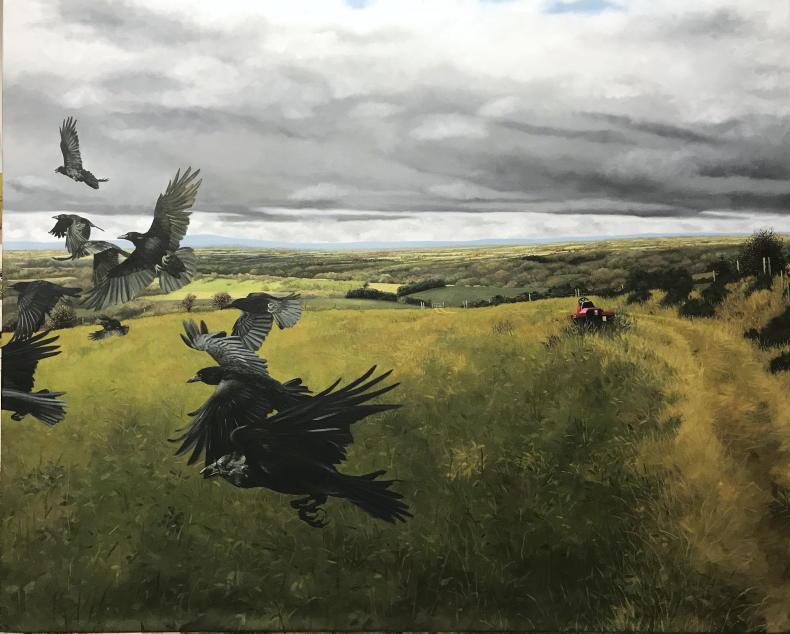
Incident, 2020 – an oil canvas painting by Martin Gale.
“There’s a quad, but there’s no one on it. You wonder what startled the birds. There’s some occurrence that we’re not privy to that has caused the birds to get up in a hurry. I wanted to paint it as if we were among the birds, so they’re up close. The location for that is up above Hollywood in Co Wicklow.”
“Unfinished narratives, that’s what they are, because there’s no point in having a beginning, middle and end, because that completes it. People can look at it and they can bring something to it themselves, ‘What’s that all about? It could be this, it could be that.’”
On art and accessibility, Martin does agree that often people feel intimidated by art, but he says it shouldn’t be over complicated.
“You get a lot of people saying, ‘Oh I don’t know much about that.’ You don’t have to, just look at it, you either like it or you don’t. It is what it is. It’s not a puzzle for you to solve. It’s not there to intimidate you.
You either like it or you don’t. It is what it is
“People think art is something highfalutin. If you really want to get into it, it’s a fault of the education system that visual education was never on the curriculum [in a serious way], which is a pity, because it effects everything, really.”
Looking back, Martin is delighted to have made the decision to “paddle his own canoe” and forge a path as a painter.
“I’m doing what I love and getting paid for it sometimes,” he smiles.
Martin is one of the artists this year taking part in Incognito. He has done so since the very beginning of the Jack and Jill fundraising initiative.
Incognito sees artists donating their art for Jack and Jill. What’s different about Incognito is that the buyer has no idea who the artist is until after the sale closes and the mask drops, when the artist’s name is then unveiled.
This year it will take place on Thursday 21 April.
Now in its sixth year, with over 1,500 artists taking part, it’s €65 for each postcard-sized artwork.
For more information and the full collection of work see incognito.ie.
Read more
DIY: for the love of art; studying at the NCAD
My Country Living: shepherd a big believer in art as therapy
Many years ago, sitting in the reception of the Irish Farmers Journal HQ awaiting a job interview, I remember looking around for something, anything, to concentrate on to forget about the nerves.
There was a painting on the wall across from me. A striking piece across three canvases depicting cows grazing in a field. I studied it intently until I was called.
It’s still there, but I actually never knew who painted it until- by happy coincidence- I sat across from him for this interview.
Based in Co Kildare, the majority of Martin Gale’s work is rooted in rural landscapes. As child he always loved the outdoors, which he was exposed to in abundance as his family worked with horses.

Keep Walking, 2016 – an oil canvas painting by Martin Gale.
“We moved around when we were young, my father was attached to different racing stables, we even spent time in England,” says Martin, as we chat in the studio in his home.
“But we always lived in the countryside and I was one of those nerdy kids who had a real interest in wildlife, birds and being outside. So that was in the DNA.”
Martin had no interest in the equine side of things, but a lot of his family were also amateur painters and he really took to art, deciding to go to art college after school.
“When I left school I said I might go to art college. It was kind of, good luck with that, I hope it stays fine for you. You paddle your own canoe with that one, because there’s no career path to follow as such. You’re taking a chance.
“I went to the art college, some of it for the wrong reasons, because I wanted to be an art student. They looked like they were having more fun than anyone else. I think I told my parents I was going to study something that would get me into television, which of course, the minute I got in there and smelt the oil paint, I was gone. It was what I wanted to do.”
I went to the art college, some of it for the wrong reasons, because I wanted to be an art student. They looked like they were having more fun than anyone else
By the time he left college during the 70s, Martin had already exhibited. He then started working with the Taylor Gallery in Dublin, whom he is still attached to. During this period, however, things were sometimes tough and Martin drove a school bus on the side until he was inducted into a then new scheme introduced by Charlie Haughey, Aosdána.
“The 70s were difficult,” Martin explains. “Then coming into the 80s, the Government introduced a scheme called Aosdána, which I was lucky enough to get into. You have to be elected into it. That gave you a stipend, now it was small, but it was enough to keep you off the breadline, so you could concentrate on your work and still survive.”
Since then, Martin’s footprint in the art world has grown and grown.
Unfinished narratives
As mentioned earlier, much of Martin’s work is landscape based, painted in a realistic style. But it’s more than just that.
Martin says that his paintings have an “unfinished narrative”.
“The paintings have always been landscape based, but they’re not specifically about the landscape. I tend to use the landscape a bit like a stage where you can set different narratives,” he explains. “There’s always something else going on, there’s a suggestion of a story.”
He gives the example of one of his paintings, Incident, which shows a field with a quad and crows flying.

Incident, 2020 – an oil canvas painting by Martin Gale.
“There’s a quad, but there’s no one on it. You wonder what startled the birds. There’s some occurrence that we’re not privy to that has caused the birds to get up in a hurry. I wanted to paint it as if we were among the birds, so they’re up close. The location for that is up above Hollywood in Co Wicklow.”
“Unfinished narratives, that’s what they are, because there’s no point in having a beginning, middle and end, because that completes it. People can look at it and they can bring something to it themselves, ‘What’s that all about? It could be this, it could be that.’”
On art and accessibility, Martin does agree that often people feel intimidated by art, but he says it shouldn’t be over complicated.
“You get a lot of people saying, ‘Oh I don’t know much about that.’ You don’t have to, just look at it, you either like it or you don’t. It is what it is. It’s not a puzzle for you to solve. It’s not there to intimidate you.
You either like it or you don’t. It is what it is
“People think art is something highfalutin. If you really want to get into it, it’s a fault of the education system that visual education was never on the curriculum [in a serious way], which is a pity, because it effects everything, really.”
Looking back, Martin is delighted to have made the decision to “paddle his own canoe” and forge a path as a painter.
“I’m doing what I love and getting paid for it sometimes,” he smiles.
Martin is one of the artists this year taking part in Incognito. He has done so since the very beginning of the Jack and Jill fundraising initiative.
Incognito sees artists donating their art for Jack and Jill. What’s different about Incognito is that the buyer has no idea who the artist is until after the sale closes and the mask drops, when the artist’s name is then unveiled.
This year it will take place on Thursday 21 April.
Now in its sixth year, with over 1,500 artists taking part, it’s €65 for each postcard-sized artwork.
For more information and the full collection of work see incognito.ie.
Read more
DIY: for the love of art; studying at the NCAD
My Country Living: shepherd a big believer in art as therapy






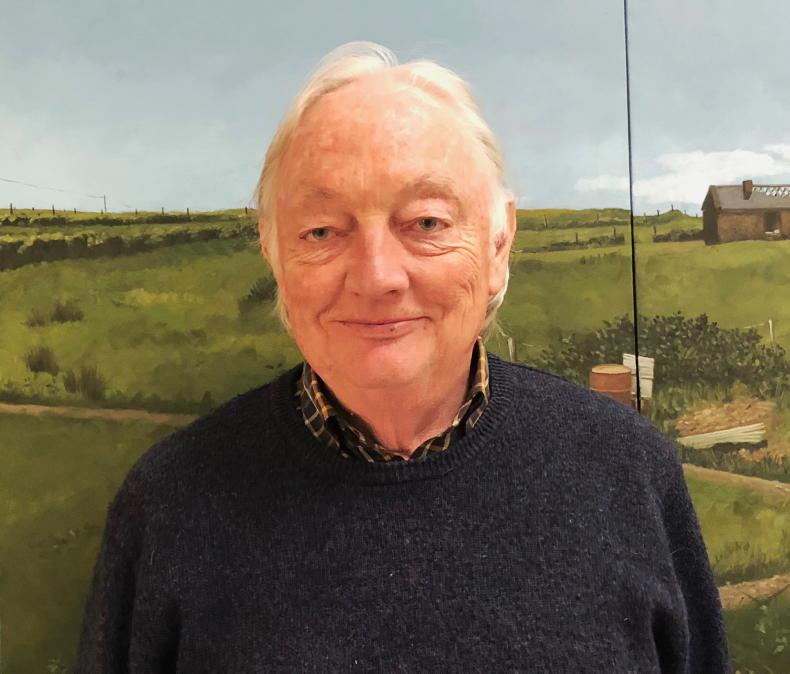
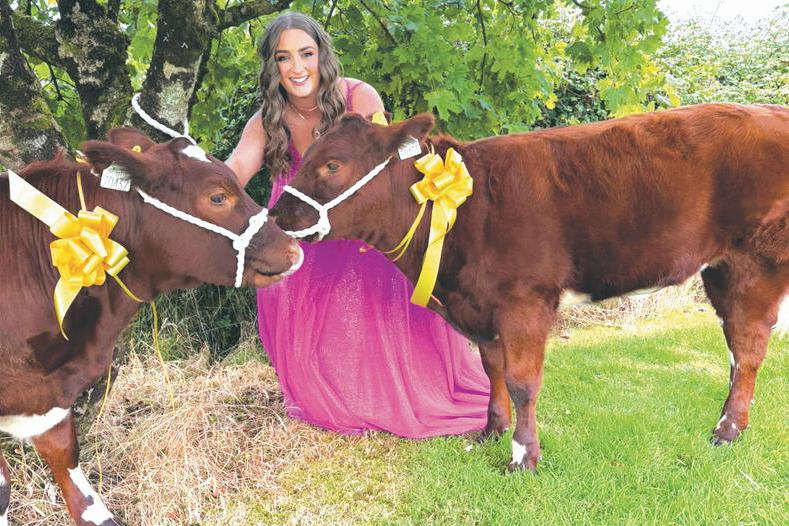
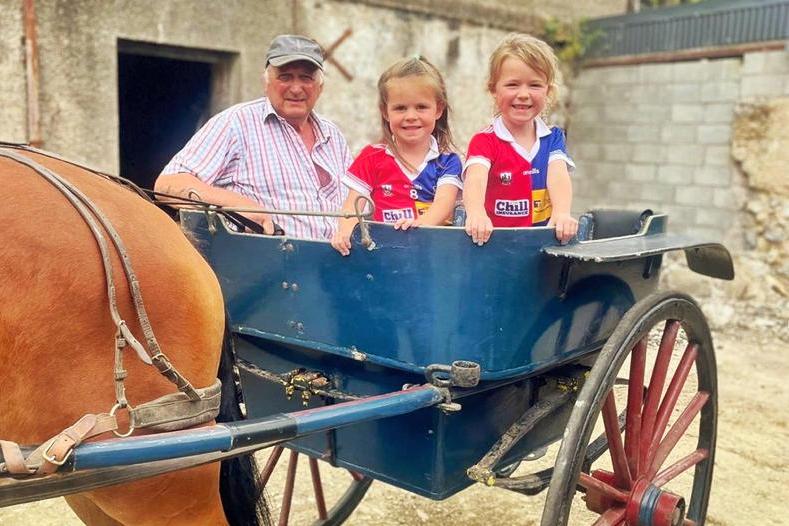
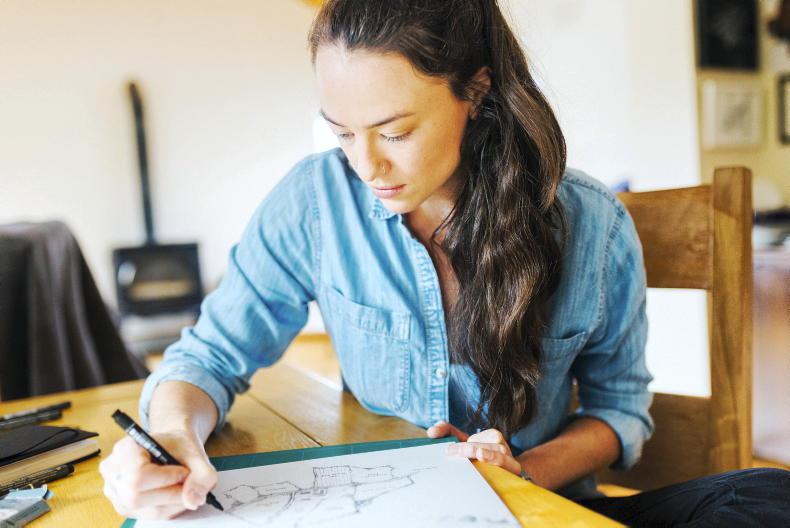
SHARING OPTIONS